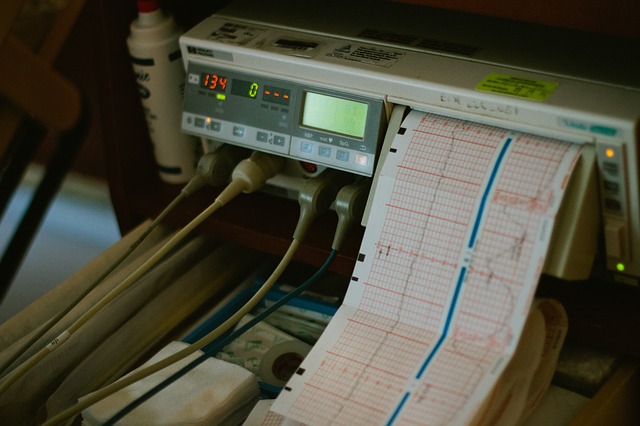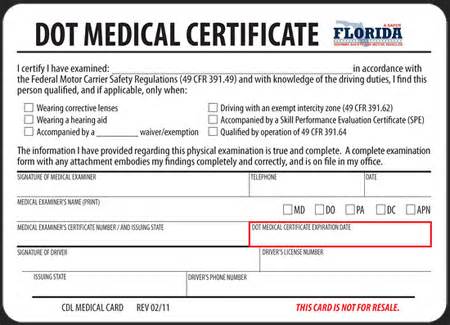What is a D.O.T. physical?
This article will go in depth on what a D.O.T. physical is, who needs one, and what the exam consists of.
So, what exactly is a D.O.T. physical?
A D.O.T. physical is an exam which leads to obtaining medical certification recognized by Federal Motor Carrier Safety Administration (A branch of the Department of Transportation). It is a federally required program that ensures that all commercial motor vehicle operators are safe and fit to perform their functions while operating a commercial motor vehicle. The exam involves several tests and observations which are listed in detail below.
Who is required to take a D.O.T. physical?
All commercial drivers involved in interstate commerce within the United States are required to obtain medical certification from an authorized medical examiner. This is accomplished through submitting to a D.O.T. physical.
More specifically this requirement applies to the following:
- Operator of a motor vehicle with a gross vehicle weight rating (GVWR), gross combination weight rating (GCWR), gross vehicle weight (GCW), or gross combination weight (GCW) of 4,536 kilograms (10,000 pounds) or more in interstate commerce
- Operator of a motor vehicle designed or used to transport more than 15 passengers (including the driver) in interstate commerce
- Operator of a motor vehicle designed or used to transport more than 15 passengers (including the driver) in interstate commerce
- Operator of a motor vehicle designed or used to transport between 9 and 15 passengers, for direct compensation, beyond 75 air miles from the driver's normal work-reporting location, in interstate commerce
- Operator who is transporting hazardous materials, in a quantity requiring placards, in interstate commerce
In addition, if you driver intrastate (within your home state) the following also applies:
Intrastate drivers are subject to the physical qualification regulations of their States. All 50 States have adapted their regulations based on some of the Federal requirements. Many states grant waivers for certain medical conditions.
NOTE: FedEx, UPS and DHL drivers usually do not leave the state but are subject to interstate regulations.
Who can perform a D.O.T. physical?
A Department of Transportation (DOT) physical examination must be conducted by a licensed "medical examiner" listed on the Federal Motor Carrier Safety Administration (FMCSA) National Registry. The term includes, but is not limited to, doctors of medicine (MD), doctors of osteopathy (DO), physician assistants (PA), advanced practice nurses (APN), and doctors of chiropractic (DC).
Where can I find a licensed and recognized Medical Examiner?
Follow this link to find a medical examiner that is certified by the FMCSA to perform DOT physical exams: https://nationalregistry.fmcsa.dot.gov/NRPublicUI/Drivers.seam
In addition you can find the following service providers very useful in locating a practitioner to complete your exam.
http://teamcme.com/locations/cdl-physicals
http://www.cvs.com/minuteclinic/resources/dot-physicals
What are the D.O.T. physical requirements for a driver?
I will forewarn you that this section is a little lengthy, however if you will take the time to read through it, it will definitively answer your question of: Am I qualified to be a Commercial Driver?
According to Federal Regulation §391.41 PHYSICAL QUALIFICATIONS FOR DRIVERS
(a) A person shall not drive a commercial motor vehicle unless he is physically qualified to do so and, except as provided in §391.67, has on his person the original, or a photographic copy, of a medical examiner's certificate that he is physically qualified to drive a commercial motor vehicle.
(b) A person is physically qualified to drive a motor vehicle if that person:
(1) Has no loss of a foot, a leg, a hand, or an arm, or has been granted a Skill Performance Evaluation (SPE) Certificate (formerly Limb Waiver Program) pursuant to §391.49.
(2) Has no impairment of: (i) A hand or finger which interferes with prehension or power grasping; or (ii) An arm, foot, or leg which interferes with the ability to perform normal tasks associated with operating a commercial motor vehicle; or any other significant limb defect or limitation which interferes with the ability to perform normal tasks associated with operating a commercial motor vehicle; or has been granted a SPE Certificate pursuant to §391.49.
(3) Has no established medical history or clinical diagnosis of diabetes mellitus currently requiring insulin for control;
(4) Has no current clinical diagnosis of myocardial infarction, angina pectoris, coronary insufficiency, thrombosis, or any other cardiovascular disease of a variety known to be accompanied by syncope, dyspnea, collapse, or congestive cardiac failure.
(5) Has no established medical history or clinical diagnosis of a respiratory dysfunction likely to interfere with his ability to control and drive a commercial motor vehicle safely.
(6) Has no current clinical diagnosis of high blood pressure likely to interfere with his ability to operate a commercial motor vehicle safely.
(7) Has no established medical history or clinical diagnosis of rheumatic, arthritic, orthopedic, muscular, neuromuscular, or vascular disease which interferes with his ability to control and operate a commercial motor vehicle safely.
(8) Has no established medical history or clinical diagnosis of epilepsy or any other condition which is likely to cause loss of consciousness or any loss of ability to control a commercial motor vehicle;
(9) Has no mental, nervous, organic, or functional disease or psychiatric disorder likely to interfere with his ability to drive a commercial motor vehicle safely;
(10) Has distant visual acuity of at least 20/40 (Snellen) in each eye without corrective lenses or visual acuity separately corrected to 20/40 (Snellen) or better with corrective lenses, distant binocular acuity of at least 20/40 (Snellen) in both eyes with or without corrective lenses, field of vision of at least 70degrees in the horizontal meridian in each eye, and the ability to recognize the colors of traffic signals and devices showing standard red, green and amber;
(11) First perceives a forced whispered voice in the better ear not less than 5 feet with or without the use of a hearing aid, or, if tested by use of an audiometric device, does not have an average hearing loss in the better ear greater than 40 decibels at 500 Hz, 1,000 Hz and 2,000 Hz with or without a hearing device when the audiometric device is calibrated to the American National Standard (formerly ASA Standard) Z24.5-1951;
(12)(i) Does not use any drug or substance identified in 21 CFR 1308.11 Schedule I, an amphetamine, a narcotic, or other habit-forming drug. (ii) Does not use any non-Schedule I drug or substance that is identified in the other Schedules in 21 part 1308 except when the use is prescribed by a licensed medical practitioner, as defined in § 382.107, who is familiar with the driver’s medical history and has advised the driver that the substance will not adversely affect the driver’s ability to safely operate a commercial motor vehicle.
(13) Has no current clinical diagnosis of alcoholism.
What does a D.O.T. physical consist of?
This will outline specifically what is included on your actual physical examination. The absolute best way to do this to download and print the following official Medical Examination Form provided by the FMCSA here: https://www.fmcsa.dot.gov/sites/fmcsa.dot.gov/files/docs/Medical_Examination_Report_for_Commercial_Driver_Fitness_Determination_0.pdf
This is the actual document filled out by the medical examiner. I will outline the steps involved in the exam, but you will find an excellent resource on pages 4 to 8 of this document in that it outlines not only the physical requirements listed above, but gives all appropriate guidelines for the medical examiner, so if you have any concern you can look through this section and find the appropriate standards.
Driver Information
The first portion of the exam consists of obtaining your (the driver’s) personal information such as name, address, driver’s license number, class of driver license etc.
Health History
The Second portion deals with your health history which asks questions in a variety of areas in order to discover any disqualifying conditions. This is one of the main reasons you should review the above qualifications prior to submitting for exam. There are several areas (blood pressure for example) that you may meet the requirements for, but that you may need a document completed by your primary care Physician. An example of such a document (provided by http://dotphysicaldoctor.com) is a good resource to be completed if applicable to your situation. You can find a copy here: http://dotphysicaldoctor.com/wp-content/uploads/2015/02/PCP-Medical-Release-2.0.pdf
After completing this section of the form you are certifying that the information is correct by your signature.
Eye Test
The third portion of the exam consists of an eye test completed using the standards that were listed above.
Hearing Exam
Fourth is a hearing exam, also with the standards listed above.
Blood Pressure/Pulse Rate

Fifth is the blood pressure/pulse rate exam. It is required that two readings be taken. Readings under 140/90 are a qualifying pass. This qualifies for a two year medical certification. Numbers above this do not necessarily result in a failing test. The following apply:
140-159/90-99 the certification is good for one year, then the recertification is also usually yearly.
160-179/100-109 the certification is good for a one time three month period to reduce the blood pressure to equal to or under 140/90. The ongoing certification is usually yearly.
180/110 the driver is disqualified until treatment and blood pressure equals 140/90 and below. In addition medical certification is usually only good for six months before required re-exam.
Lab Testing
A urinalysis is required and the purpose is to look for protein, blood, or sugar in the urine. A drug screen is not conducted at this time, and is usually a part of your pre-hire physical with your employing company.
Physical Exam
Consisting of a documentation of your height and weight and then a check of the following:
- General Appearance
- Eyes
- Ears
- Mouth and Throat
- Heart
- Lungs and Chest
- Abdomen
- Vascular system
- Hernias
- Extremities/Limbs
- Spine/Musculoskeletal
- Neurological
The details of which can be found on the FMSCA form previously referenced.
Certification status
At the conclusion of the exam the Medical Examiner will make a determination of qualification regarding the driver. This will determine if the driver receives his or her CDL medical card and also determines when the driver is due to come back for re-exam. The standard is a certification and medical card for two years, but as mentioned previously certifications can also be issued for one year, six months, or three months dependent on the circumstances.
Can exemptions be obtained?
According to the FMCSA: Under 49 United States Code 31315 and 31136(e), the FMCSA may grant an exemption from the FMCSRs if the agency determines it is in the public interest and would likely achieve a level of safety equivalent to, or greater than, the level that would be achieved by complying with the safety regulation. Section 381.300 through 381.330 of the FMCSRs describes procedures applicants must follow to apply for exemptions and can be viewed at 49 CFR 381.330. FMCSA currently has exemption programs for vision and insulin-treated diabetes mellitus, and offers a certificate program for drivers with limb impairments. FMCSA also has a special certification program for drivers with missing and/or impaired limbs (49 CFR 391.41(b)(1).
What happens if I fail the D.O.T. physical?
In some instances you are given a three month certification to correct and treat conditions and then required to report back to the Medical Examiner and complete a new physical. If you have a condition that is listed above in the requirements, unless an exemption is obtained you will not be eligible to acquire a medical certification card. It should be noted that the results are transmitted to D.O.T. and will be listed on your records.
CDL Medical Card

At the completion of your exam and successfully passing it you will obtain directly from the Medical examiner a CDL Medical Card. This document is also known as a D.O.T. medical certificate, and/or a D.O.T. physical card. It should be carried with you at all times, and the long form copy that the Medical Examiner completes should be stored safely in your records.
What does a D.O.T. physical cost?
Costs will vary, the best that you can do is to visit the sites that were supplied above and check with your local Medical Examiner’s office. The approximate cost however is somewhere in the range of between $50 to $250 Dollars. You may check with your health insurance company to see if it can be covered as a wellness visit, which most plans allow for with minimal or no cost. In addition, if you have a pre-hire with any companies most time these costs are absorbed by that employer.
Where can I get more information?
You should consider checking with your local Medical Examiner who is listed in the FMCSA registry and also check out the official D.O.T./FMCSA site at: https://www.fmcsa.dot.gov/
In addition, be sure to pick up our FREE guides on:
- 6 Hacks for boosting pay as a new Truck Driver
- Avoiding the 11 biggest mistakes before starting CDL School
- And our Cheat sheet checklist of what to ask trucking company recruiters.

